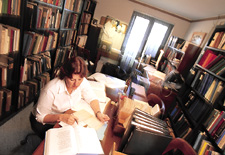Martha
Roth, Oriental Institute
The number on Martha Roth's office door is painted in gold, outlined
in black, and belongs to an earlier era. Inside Room 325 of the
Oriental Institute, Roth is at work on another product of an earlier
time, editing the ".T" (pronounced "tet") volume of the Chicago
Assyrian Dictionary (CAD). Begun in 1921 by James Henry Breasted,
the CAD project is a comprehensive compilation of the dialects
of Akkadian, the earliest known Semitic language recorded on cuneiform
texts, dating from c. 2400 bc to 100 ad.
 |
| Martha
Roth, Oriental Institute |
Roth, a professor in the Oriental Institute, Near
Eastern languages & civilizations, the ancient Mediterranean world,
Jewish studies, and the College, has been with the project since
she came to Chicago in 1979. In 1996, she was named editor-in-charge,
following in the footsteps of longtime editors Erica Reiner, PhD'55
(1973-96) and A. Leo Oppenheim (1955-73). In 1955, 34 years after
Breasted began work, Oppenheim produced the series' first volume,
No. 9, covering the phonemes associated in English with the letter
"H." From then on, the publishing pace has been measured, but
steady.
The end, says Roth, is in sight. In April, Volume
"R" appeared, and two volumes, covering the "P" and "T" phonemes,
are in press this summer, scheduled to appear in 2002. Meanwhile,
three research associates, supported by a three-year, $475,000
National Endowment for the Humanities grant that began in July,
are ready to draft the final volume, covering the sounds represented
by "U" and "W."
Despite changing interpretations in the scholarly
world since the appearance of the "H" volume, the editors hold
fast to the standards it set. "We have to stick with the conventions
of the first volume," Roth says, "because a new volume doesn't
stand alone," but is seen in the same context as all the volumes
that have come before. Could there be another dictionary project,
taking advantage of later scholarly perspectives? "The world is
different," Roth responds. "Having done this, we have changed
the world."
Instead, she envisions "smaller projects, taken
on by scholars interested in the dialects of a geographical area,
a particular temporal movement, or a literary genre-scientific
texts or letters from the Old Babylonian period." Such smaller
projects, she estimates, should take about 20 years-though she
won't be undertaking one herself.
Martha Roth's own academic specialty is family and
legal history in Mesopotamia (every other year, she teaches a
course at the Law School), and she's finishing up several articles
on those subjects. She's also doing an independent study with
an undergraduate who's studying Mesopotamian literature. When
the dictionary is finished, she says happily, "I'll do a lot more
teaching."
For now, it's back to the dictionary, with no trace
of regret. "It's a 12-month-a-year project," Roth says, comparing
the editor's role to that of a lab scientist tending an experiment:
"You can't go away and leave it for a while."
Laura Letinsky, Committee on the Visual Arts
Switching on the computer in her Gates-Blake office,
crowded with her color photographs, framed and unframed, Laura
Letinsky, an associate professor in the Committee on Visual Arts,
admits that it's been weeks since she's been able to check her
e-mail. "This is scary," she says, retrieving the messages. For
the past few weeks, she's been concentrating on moving with her
husband and their almost 2-year-old son to the home they just
bought in Hyde Park.
 |
|
Laura
Letinsky, Committee
on the Visual Arts
|
The move wasn't out of the ordinary- "I've moved
almost every year." What's made the summer atypical is the convergence
of projects. Recently named a Guggenheim fellow, Letinsky will
spend the coming academic term traveling in Italy while working
on a series of domestic still lifes she calls Morning, and
Melancholy. The series, she says, "grew fairly organically"
out of another series, Venus Inferred. A book of photographs
from that series-images she describes as "large and visually lush
color photographs of heterosexual couples," including herself
and her husband-will be published this fall by the University
of Chicago Press. Her work also appears in three group shows this
summer, one in New York and two in Chicago, with a solo show from
the Morning, and Melancholy project in Chicago this fall.
Her Venus Inferred series "is about romance
and love," Letinsky says, "trying to deal with the desire for
a kind of idealized love story, while recognizing the fact that
that's an impossibility." Her new series moves "from the couples
to the world that the couples created: the way you try to stage
'home' and what home means to you. And, again, it portrays the
wanting of your world to be beautiful but also the kinds of compromises
one must make.
"I've been wanting to make pictures about the aftermath,"
Letinsky continues, "the loss of this idealized moment, not in
a way that was filled with desperation or disappointment but in
a way that also shows, still, a kind of aspiration."
So far, the photographs for the new series have
been of her own domestic spaces: "I am a material person-I like
objects, and I've always enjoyed secondhand shopping and collecting
things that I think are really beautiful. I'll find a gorgeous
ceramic green vase and then another antique that has a chip in
it. It's still beautiful but it's obsolete because nobody no longer
wants it." One such found and photographed object is "a blue vase
that I picked up for 25 cents at a flea market-it's a turquoise
blue crackle-glaze vase that I really love."



![]()

